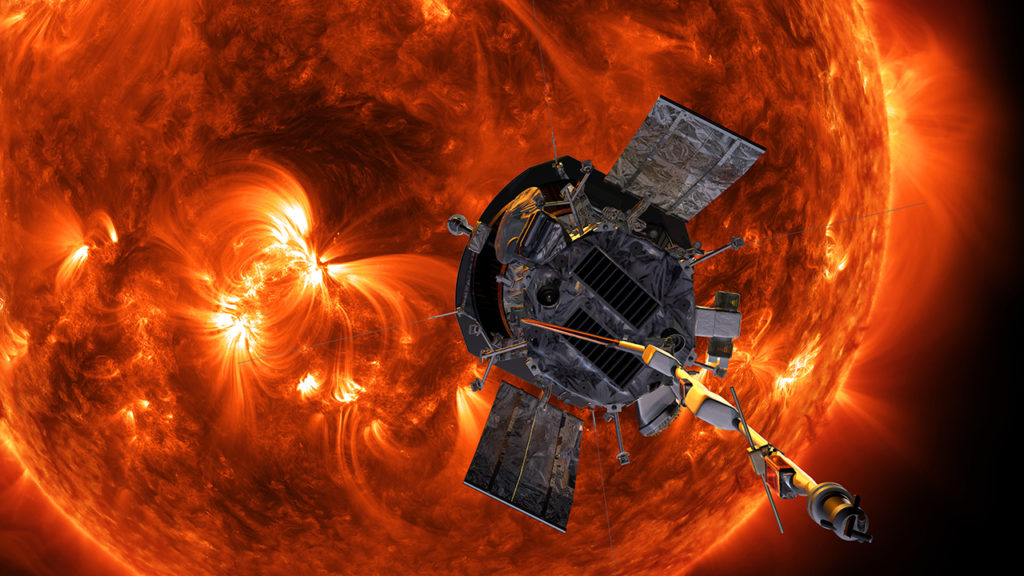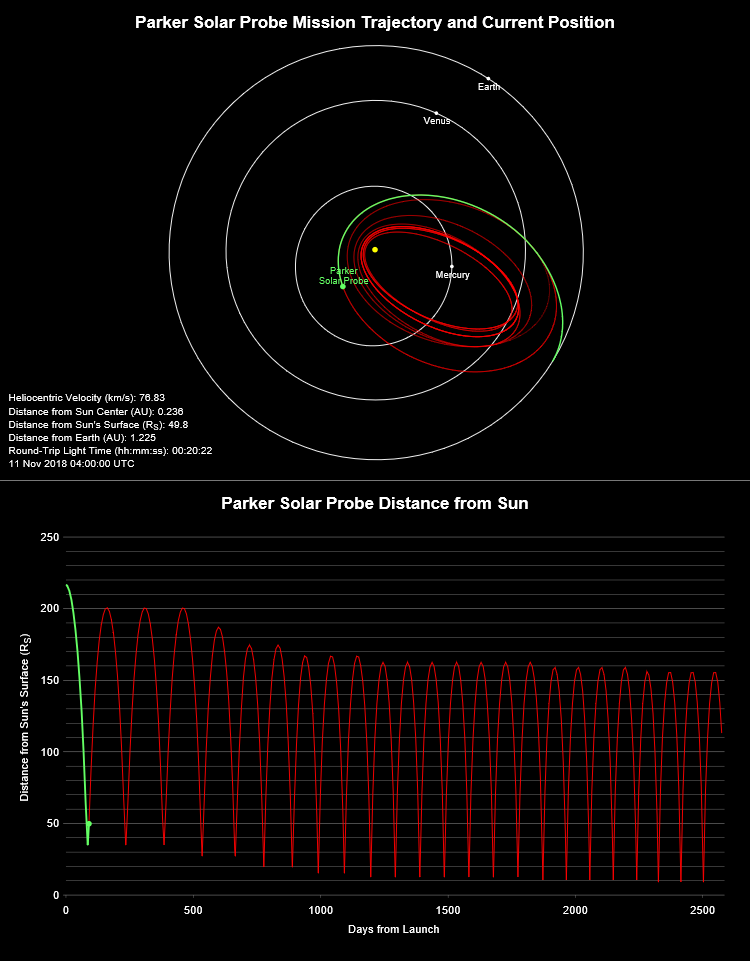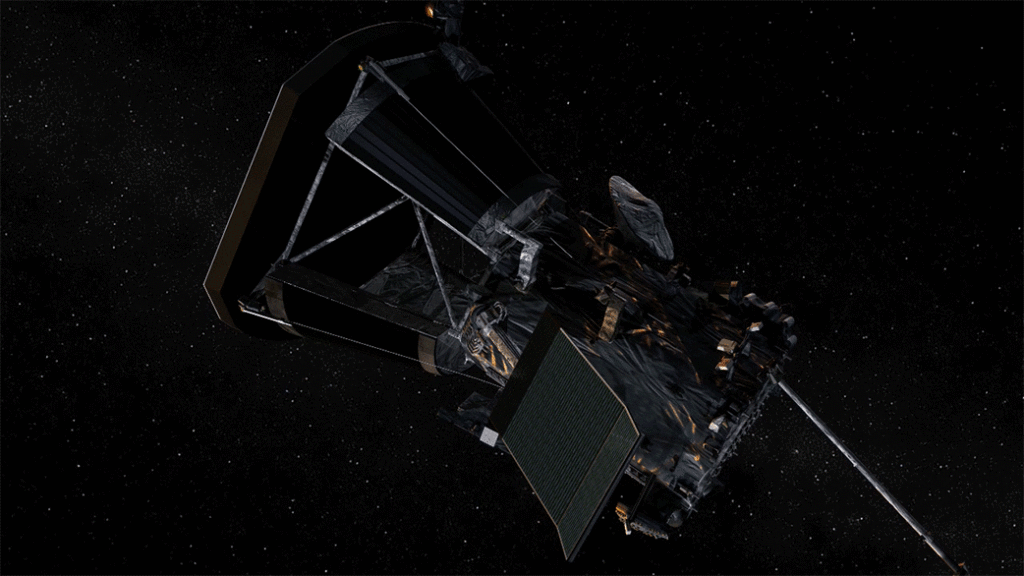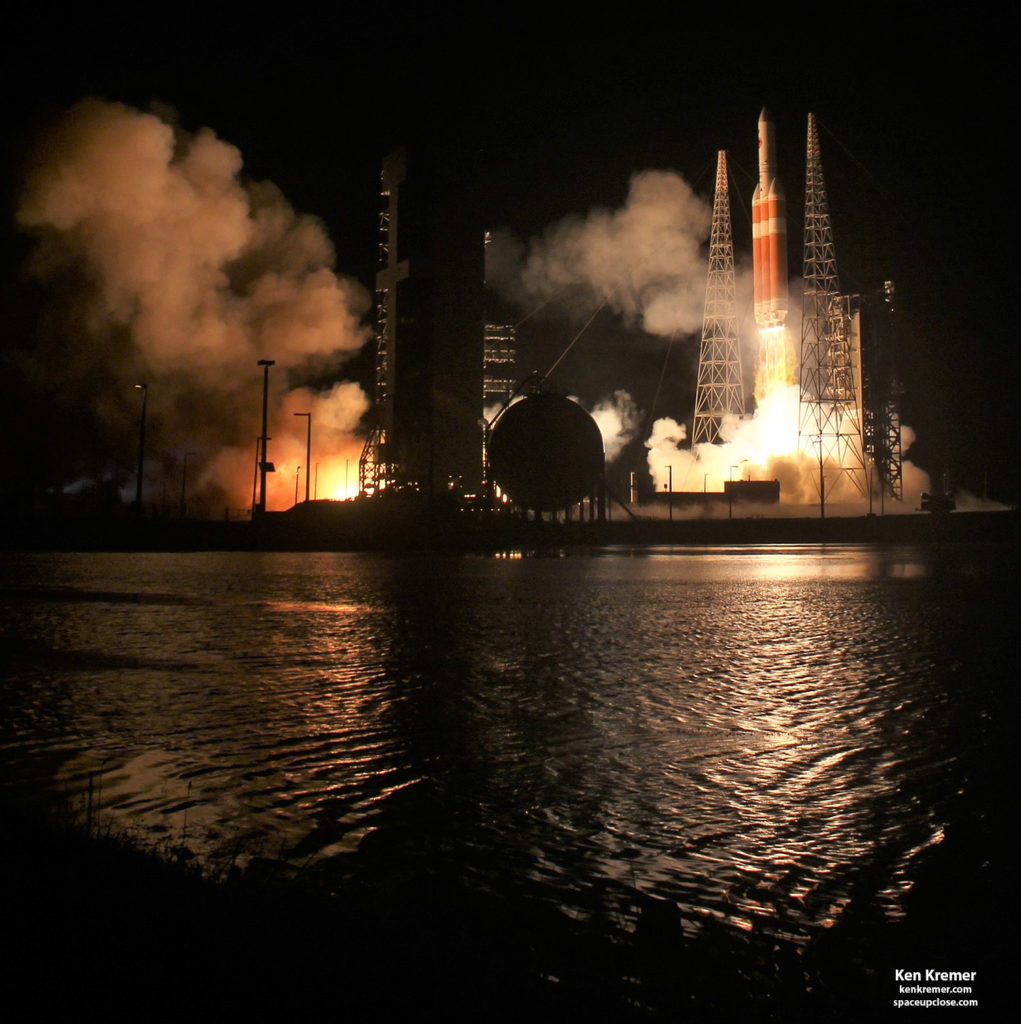 |
|
Illustration of NASA’s
Parker Solar Probe approaching the Sun. Credit: NASA/Johns Hopkins APL/Steve Gribben |
object ever in human history, NASA’s Parker Solar Probe survived its record
setting 1st close encounter with the sun on Monday, Nov. 5 – less
than three months after blasting off from the Florida Space Coast.
the $1.5 Billion science probe plunged to within a record breaking 15 million
miles (24
million kilometers) of the suns
blazing hot surface and intense radiation – while speeding by at a truly phenomenal
and likewise record breaking velocity of 213,200 miles per hour (343,112 km/h).
receiving radio signals following the successful flyby for confirmation that the
spacecraft was indeed alive and well and intact to carry out her seven-year
long mission to “touch” the sun and fly through the solar corona for unprecedented science
gathering operations.
“Parker Solar Probe is alive and well after skimming by the
Sun at just 15 million miles from our star’s surface,” NASA reported on Nov. 7.
The probe was operating autonomously and out of contact with
mission controllers at
the Johns Hopkins University Applied Physics Lab since
it was so close to the sun.
The moment of closest approach was 10:28 p.m. EST Monday Nov.
5 (0328 GMT Tuesday Nov. 6). The encounter period
began on Oct. 31.
“Mission controllers at the Johns Hopkins University Applied Physics Lab received
the status beacon from the spacecraft at 4:46 p.m. EST (2146 GMT) on Nov. 7,
2018,” said NASA.
“The beacon indicates
status “A” — the best of all four possible status signals, meaning
that Parker Solar Probe is operating well with all instruments running and
collecting science data and, if there were any minor issues, they were resolved
autonomously by the spacecraft.”
It currently takes
about 18 minutes for a round trip signal from the spacecraft to reach Earth and
return to the probe – which is approximately 1.2 AU (110 million miles, 180
million km) distant from Earth.
 |
|
Parker Solar Probe Mission
Trajectory and Current Position after 1st solar perihelion in Nov 2018. Credit: NASA/APL/Parker Solar Probe |
On Oct. 29 Parker already smashed through the
existing 42 years old record set by the German-American Helios 2
spacecraft back in April 1976 – and will continue setting astounding
new records over the course of its seven year mission as it dives ever closer during
some two dozen solar perihelion encounters.
Parker became the closest human-made object to
the Sun in history when it plunged past the then current record of 26.55
million miles from the Sun’s surface on Oct. 29, 2018, at about 1:04 p.m. EDT.
“Parker Solar Probe was designed to take care of
itself and its precious payload during this close approach, with no control
from us on Earth — and now we know it succeeded,” said Thomas Zurbuchen, associate
administrator of NASA’s Science Mission Directorate at the agency headquarters
in Washington, in a statement.
“Parker is the culmination of six decades
of scientific progress. Now, we have realized humanity’s first close visit to
our star, which will have implications not just here on Earth, but for a deeper
understanding of our universe.”
Eventually she will swing by the sun within a
final close approach of 3.83 million miles in 2024 while soaring by at a
record-breaking speed of nearly 500,000 MPH.
During this
1st solar perihelion at 15 million miles distance the Sun-facing
side of Parker Solar Probe’s heat shield, called the Thermal Protection System,
experienced temperatures up to about 820 degrees Fahrenheit.
This
temperature will climb up to 2,500 F as the spacecraft makes closer approaches
to the Sun coming within 4 million miles.
But the TPS
is so effective that on the spacecraft facing side instruments and systems that
are protected by the heat shield are generally kept in the mid-80s F.
The 1st solar encounter period began
on Oct. 31 and lasts through Nov. 11.
Parker is equipped with four on-board science
instruments suites. Because of the probes proximity to the sun it will take several
weeks before the science data begins
downlinking to scientists on Earth.
The key goals are to try and
answer fundamental questions about the nature of the sun and develop an
understanding of how the sun works – such as why is the solar corona so hot.
Its much hotter than the suns surface.
Scientists also want to know why
the solar wind is accelerated to supersonic speeds.
The mission will conduct 7 Venus flyby’s to
set up 24 perihelion close encounters with the sun through 2024. The Venus
flyby’s will precisely
set its trajectory toward the Sun and slow the probe down instead of speeding
it up.
The $1.5 Billion mission began with a dazzling
middle-of-the-night blastoff of the mighty Delta IV Heavy rocket in the wee
hours of the morning, Aug. 12 – and delivered the car sized spacecraft to its
intended trajectory towards Venus and the Sun.
The 23-story tall triple barreled United
Launch Alliance Delta IV Heavy rocket successfully launched at 3:31 a.m. EDT
Aug. 12 from the Florida Space Coast and put on a brilliant display of fire
power with 2.1 million pounds of thrust spewing forth from the trio of liquid
oxygen/liquid hydrogen RS-68A main engines that quickly turned night into day a
few hours before the natural sunrise under nearly cloud-free skies.
Watch for Ken’s continuing onsite coverage of NASA, SpaceX, ULA,
Boeing, Lockheed Martin, Northrop Grumman and more space and mission reports direct
from the Kennedy Space Center, Cape Canaveral Air Force Station, Florida and
Wallops Flight Facility, Virginia.
Stay tuned here for Ken’s continuing Earth and Planetary science
and human spaceflight news: www.kenkremer.com –www.spaceupclose.com –
twitter @ken_kremer – email: ken at kenkremer.com
Dr. Kremer is a research scientist
and journalist based in the KSC area.
………….
Ken’s photos are for sale and he is available for lectures and outreach events



